Silicon-Vacancy Centers in Ultra-Thin Nanocrystalline Diamond Films
Abstract
1. Introduction
2. Materials and Methods
3. Results and Discussion
3.1. SiV Centers in Ultra-Thin NCD Films
3.2. Perspectives of Reversible NCD Surface Chemistry Modification by Plasma and Thermal Treatments
4. Conclusions
Author Contributions
Funding
Acknowledgments
Conflicts of Interest
References
- Aharonovich, I.; Englund, D.; Toth, M. Solid-state single-photon emitters. Nat. Photonics 2016, 10, 631–641. [Google Scholar] [CrossRef]
- Bernardi, E.; Nelz, R.; Sonusen, S.; Neu, E. Nanoscale Sensing Using Point Defects in Single-Crystal Diamond: Recent Progress on Nitrogen Vacancy Center-Based Sensors. Crystals 2017, 7, 124. [Google Scholar] [CrossRef]
- Dragounová, K.; Potůček, Z.; Potocký, Š.; Bryknar, Z.; Kromka, A. Determination of temperature dependent parameters of zero-phonon line in photo-luminescence spectrum of silicon-vacancy centre in CVD diamond thin films. J. Electr. Eng. 2017, 68. [Google Scholar] [CrossRef]
- Neu, E.; Guldner, F.; Arend, C.; Liang, Y.; Ghodbane, S.; Sternschulte, H.; Steinmüller-Nethl, D.; Krueger, A.; Becher, C. Low temperature investigations and surface treatments of colloidal narrowband fluorescent nanodiamonds. J. Appl. Phys. 2013, 113, 203507. [Google Scholar] [CrossRef]
- Müller, T.; Hepp, C.; Pingault, B.; Neu, E.; Gsell, S.; Schreck, M.; Sternschulte, H.; Steinmüller-Nethl, D.; Becher, C.; Atatüre, M. Optical signatures of silicon-vacancy spins in diamond. Nat. Commun. 2014, 5. [Google Scholar] [CrossRef] [PubMed]
- Jahnke, K.D.; Sipahigil, A.; Binder, J.M.; Doherty, M.W.; Metsch, M.; Rogers, L.J.; Manson, N.B.; Lukin, M.D.; Jelezko, F. Electron–phonon processes of the silicon-vacancy centre in diamond. New J. Phys. 2015, 17, 043011. [Google Scholar] [CrossRef]
- Lesik, M.; Raatz, N.; Tallaire, A.; Spinicelli, P.; John, R.; Achard, J.; Gicquel, A.; Jacques, V.; Roch, J.-F.; Meijer, J.; et al. Production of bulk NV centre arrays by shallow implantation and diamond CVD overgrowth. Phys. Status Solidi A 2016, 213, 2594–2600. [Google Scholar] [CrossRef]
- Stehlik, S.; Varga, M.; Stenclova, P.; Ondic, L.; Ledinsky, M.; Pangrac, J.; Vanek, O.; Lipov, J.; Kromka, A.; Rezek, B. Ultrathin Nanocrystalline Diamond Films with Silicon Vacancy Color Centers via Seeding by 2 nm Detonation Nanodiamonds. ACS Appl. Mater. Interfaces 2017, 9, 38842–38853. [Google Scholar] [CrossRef] [PubMed]
- Ondič, L.; Varga, M.; Hruška, K.; Fait, J.; Kapusta, P. Enhanced Extraction of Silicon-Vacancy Centers Light Emission Using Bottom-Up Engineered Polycrystalline Diamond Photonic Crystal Slabs. ACS Nano 2017, 11, 2972–2981. [Google Scholar] [CrossRef] [PubMed]
- Aharonovich, I.; Greentree, A.D.; Prawer, S. Diamond photonics. Nat. Photonics 2011, 5, 397–405. [Google Scholar] [CrossRef]
- Schell, A.W.; Kewes, G.; Hanke, T.; Leitenstorfer, A.; Bratschitsch, R.; Benson, O.; Aichele, T. Single defect centers in diamond nanocrystals as quantum probes for plasmonic nanostructures. Opt. Express 2011, 19, 7914–7920. [Google Scholar] [CrossRef] [PubMed]
- Choy, J.T.; Hausmann, B.J.M.; Babinec, T.M.; Bulu, I.; Khan, M.; Maletinsky, P.; Yacoby, A.; Lončar, M. Enhanced single-photon emission from a diamond–silver aperture. Nat. Photonics 2011, 5, 738–743. [Google Scholar] [CrossRef]
- Häußler, S.; Thiering, G.; Dietrich, A.; Waasem, N.; Teraji, T.; Isoya, J.; Iwasaki, T.; Hatano, M.; Jelezko, F.; Gali, A.; et al. Photoluminescence excitation spectroscopy of SiV − and GeV − color center in diamond. New J. Phys. 2017, 19, 063036. [Google Scholar] [CrossRef]
- Goss, J.P.; Briddon, P.R.; Shaw, M.J. Density functional simulations of silicon-containing point defects in diamond. Phys. Rev. B 2007, 76, 075204. [Google Scholar] [CrossRef]
- Gali, A.; Maze, J.R. Ab initio study of the split silicon-vacancy defect in diamond: Electronic structure and related properties. Phys. Rev. B 2013, 88, 235205. [Google Scholar] [CrossRef]
- Iakoubovskii, K.; Adriaenssens, G.J. Luminescence excitation spectra in diamond. Phys. Rev. B 2000, 61, 10174–10182. [Google Scholar] [CrossRef]
- Dhomkar, S.; Zangara, P.R.; Henshaw, J.; Meriles, C.A. On-Demand Generation of Neutral and Negatively Charged Silicon-Vacancy Centers in Diamond. Phys. Rev. Lett. 2018, 120. [Google Scholar] [CrossRef] [PubMed]
- Stehlik, S.; Glatzel, T.; Pichot, V.; Pawlak, R.; Meyer, E.; Spitzer, D.; Rezek, B. Water interaction with hydrogenated and oxidized detonation nanodiamonds—Microscopic and spectroscopic analyses. Diam. Relat. Mater. 2015. [Google Scholar] [CrossRef]
- Pawlak, R.; Glatzel, T.; Pichot, V.; Schmidlin, L.; Kawai, S.; Fremy, S.; Spitzer, D.; Meyer, E. Local Detection of Nitrogen-Vacancy Centers in a Nanodiamond Monolayer. Nano Lett. 2013, 13, 5803–5807. [Google Scholar] [CrossRef] [PubMed]
- Artemenko, A.; Kozak, H.; Biederman, H.; Choukourov, A.; Kromka, A. Amination of NCD Films for Possible Application in Biosensing: Amination of NCD Films for Possible Application in Biosensing. Plasma Process. Polym. 2015, 12, 336–346. [Google Scholar] [CrossRef]
- Sadewasser, S.; Glatzel, T.; Rusu, M.; Jäger-Waldau, A.; Lux-Steiner, M.C. High-resolution work function imaging of single grains of semiconductor surfaces. Appl. Phys. Lett. 2002, 80, 2979–2981. [Google Scholar] [CrossRef]
- Diesinger, H.; Deresmes, D.; Nys, J.-P.; Mélin, T. Kelvin force microscopy at the second cantilever resonance: An out-of-vacuum crosstalk compensation setup. Ultramicroscopy 2008, 108, 773–781. [Google Scholar] [CrossRef] [PubMed]
- Kronik, L.; Shapira, Y. Surface photovoltage phenomena: Theory, experiment, and applications. Surf. Sci. Rep. 1999, 37, 1–206. [Google Scholar] [CrossRef]
- D’Haenens-Johansson, U.F.S.; Edmonds, A.M.; Green, B.L.; Newton, M.E.; Davies, G.; Martineau, P.M.; Khan, R.U.A.; Twitchen, D.J. Optical properties of the neutral silicon split-vacancy center in diamond. Phys. Rev. B 2011, 84. [Google Scholar] [CrossRef]
- Barnes, W.L. Fluorescence Near Interfaces: The Role of Photonic MODE density. J. Modern Optics 1998, 45, 661–699. [Google Scholar] [CrossRef]
- Danos, L.; Greef, R.; Markvart, T. Efficient fluorescence quenching near crystalline silicon from Langmuir–Blodgett dye films. Thin Solid Films 2008, 516, 7251–7255. [Google Scholar] [CrossRef]
- Petráková, V.; Taylor, A.; Kratochvílová, I.; Fendrych, F.; Vacík, J.; Kučka, J.; Štursa, J.; Cígler, P.; Ledvina, M.; Fišerová, A.; et al. Luminescence of Nanodiamond Driven by Atomic Functionalization: Towards Novel Detection Principles. Adv. Funct. Mater. 2012, 22, 812–819. [Google Scholar] [CrossRef]
- Maier, F.; Ristein, J.; Ley, L. Electron affinity of plasma-hydrogenated and chemically oxidized diamond (100) surfaces. Phys. Rev. B 2001, 64. [Google Scholar] [CrossRef]
- Harniman, R.L.; Fox, O.J.L.; Janssen, W.; Drijkoningen, S.; Haenen, K.; May, P.W. Direct observation of electron emission from grain boundaries in CVD diamond by PeakForce-controlled tunnelling atomic force microscopy. Carbon 2015, 94, 386–395. [Google Scholar] [CrossRef]
- Orlanducci, S.; Cianchetta, I.; Tamburri, E.; Guglielmotti, V.; Terranova, M.L. Effects of Au nanoparticles on photoluminescence emission from Si-vacancy in diamond. Chem. Phys. Lett. 2012, 549, 51–57. [Google Scholar] [CrossRef]
- Ristein, J. Surface science of diamond: Familiar and amazing. Surf. Sci. 2006, 600, 3677–3689. [Google Scholar] [CrossRef]
- Verveniotis, E.; Kromka, A.; Rezek, B. Controlling Electrostatic Charging of Nanocrystalline Diamond at Nanoscale. Langmuir 2013, 29, 7111–7117. [Google Scholar] [CrossRef] [PubMed]
- Furthmüller, J.; Hafner, J.; Kresse, G. Dimer reconstruction and electronic surface states on clean and hydrogenated diamond (100) surfaces. Phys. Rev. B 1996, 53, 7334–7351. [Google Scholar] [CrossRef]
- Itoh, Y.; Sumikawa, Y.; Umezawa, H.; Kawarada, H. Trapping mechanism on oxygen-terminated diamond surfaces. Appl. Phys. Lett. 2006, 89, 203503. [Google Scholar] [CrossRef]
- Stehlik, S.; Varga, M.; Ledinsky, M.; Jirasek, V.; Artemenko, A.; Kozak, H.; Ondic, L.; Skakalova, V.; Argentero, G.; Pennycook, T.; et al. Size and Purity Control of HPHT Nanodiamonds down to 1 nm. J. Phys. Chem. C 2015, 119, 27708–27720. [Google Scholar] [CrossRef] [PubMed]
- Ahmed, A.-I.; Mandal, S.; Gines, L.; Williams, O.A.; Cheng, C.-L. Low temperature catalytic reactivity of nanodiamond in molecular hydrogen. Carbon 2016, 110, 438–442. [Google Scholar] [CrossRef]
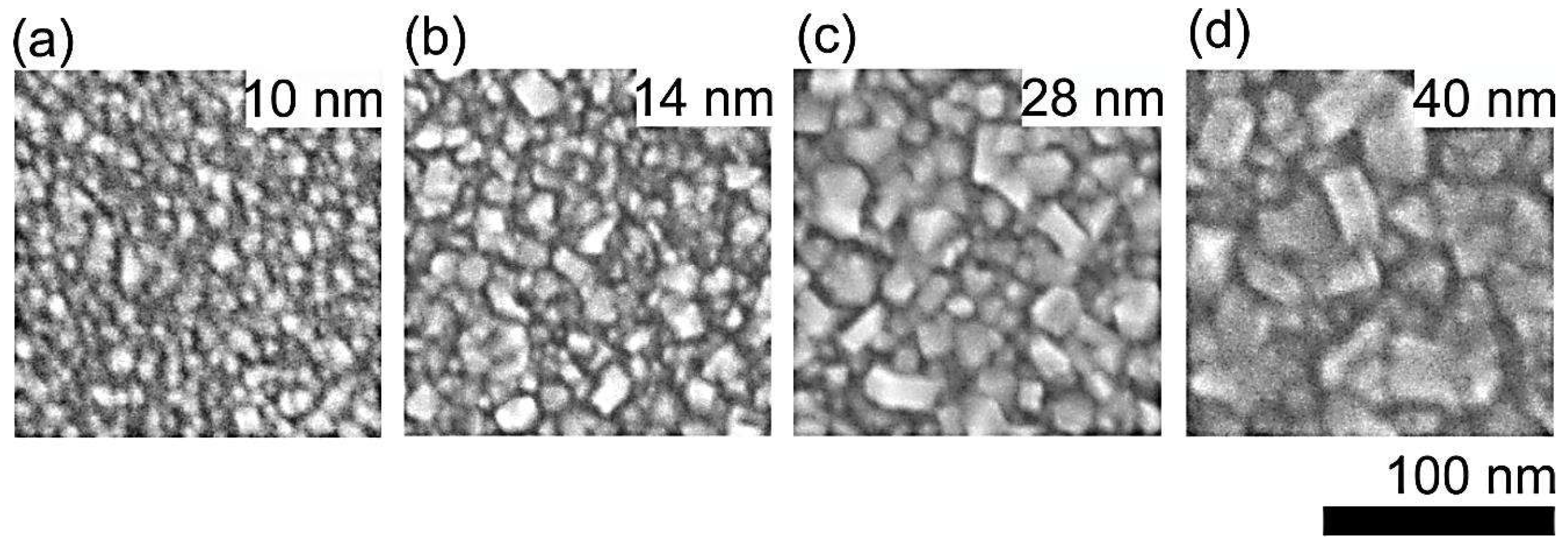
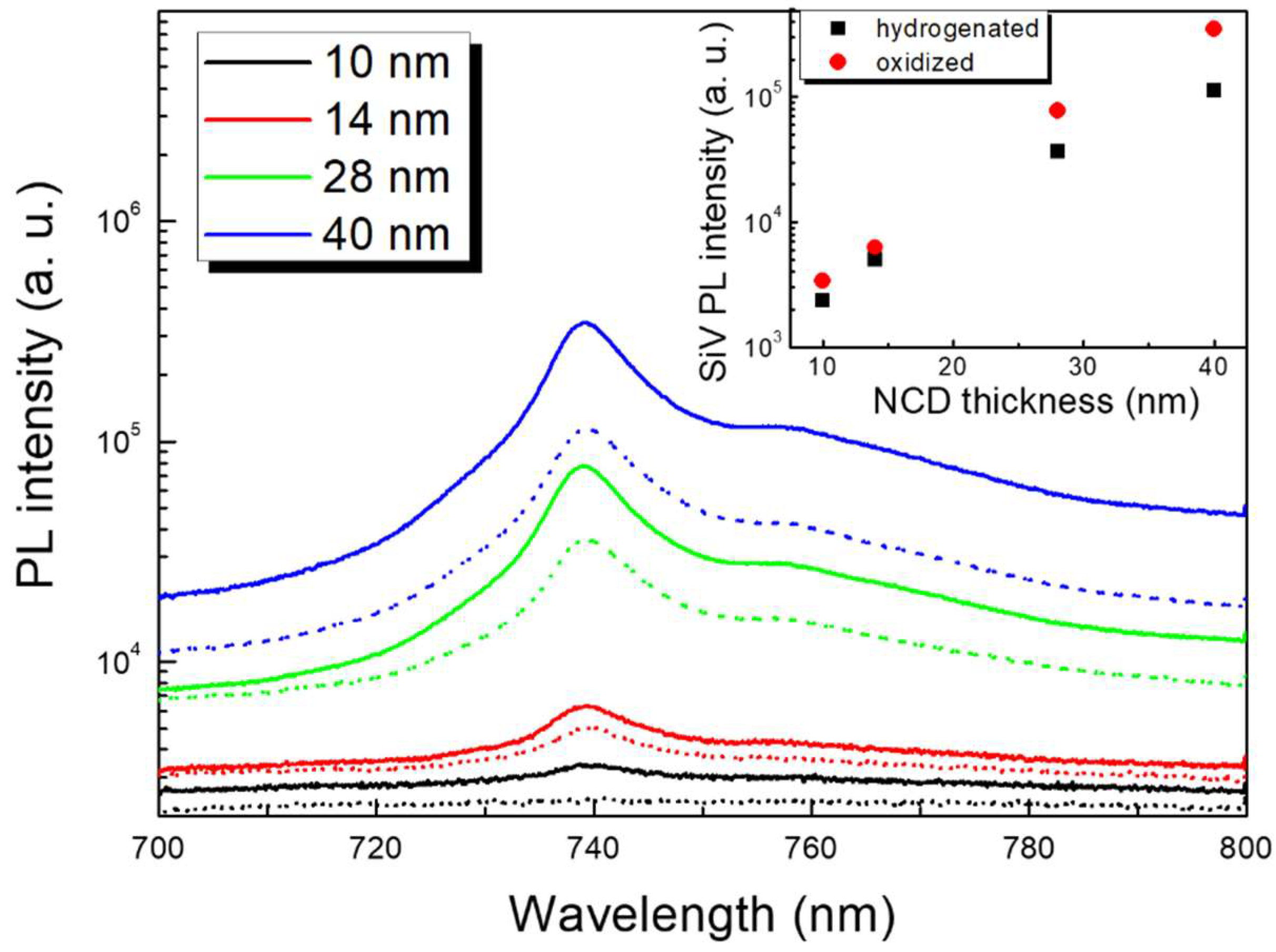
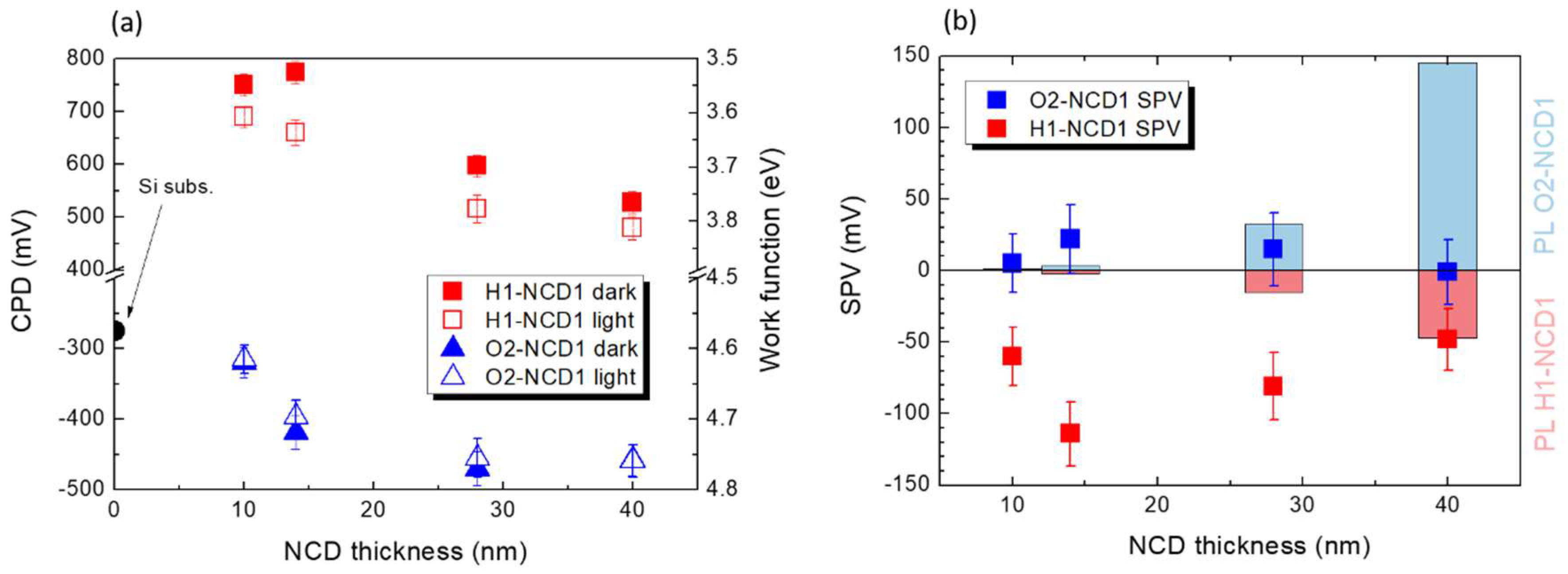
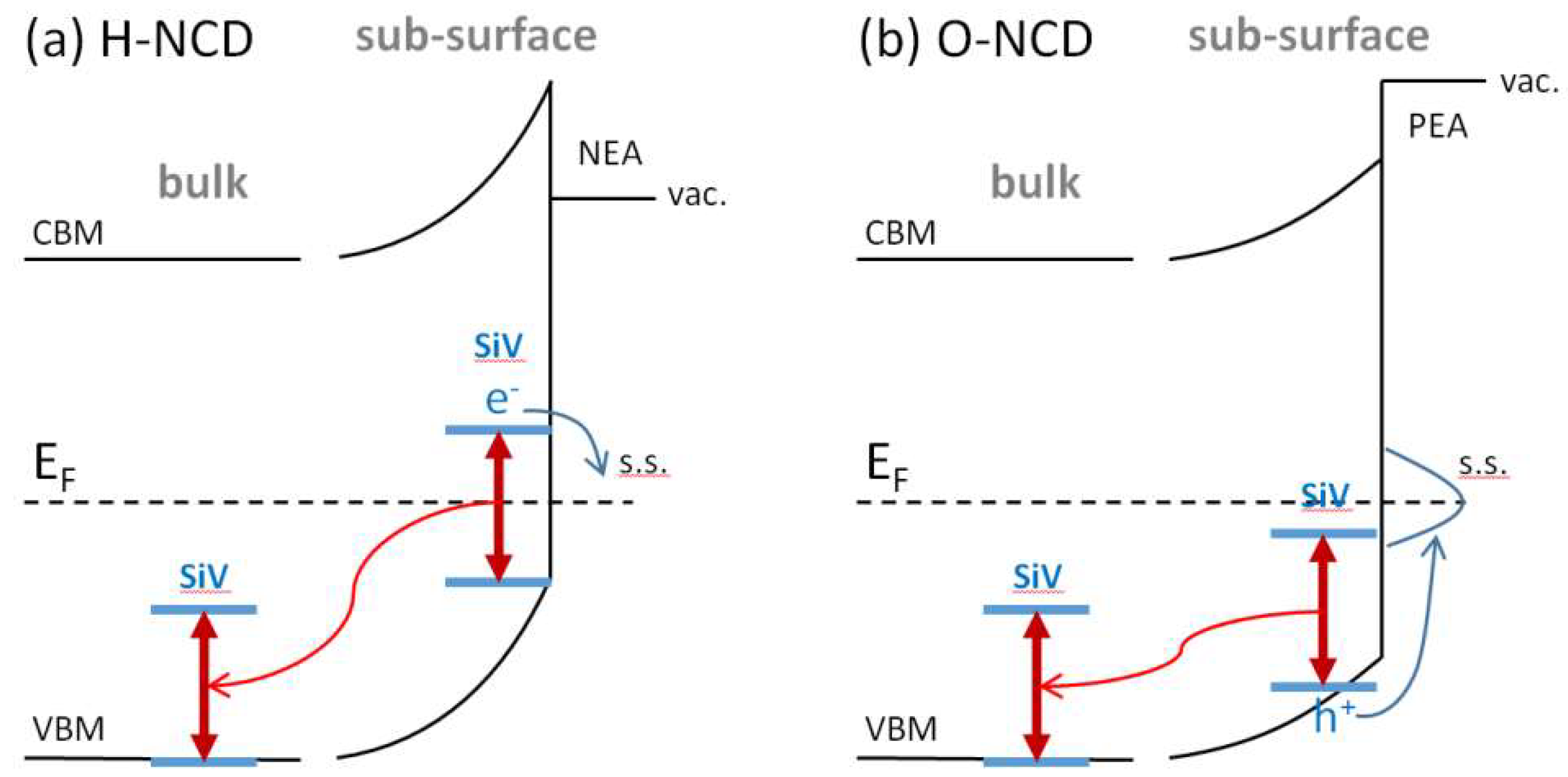
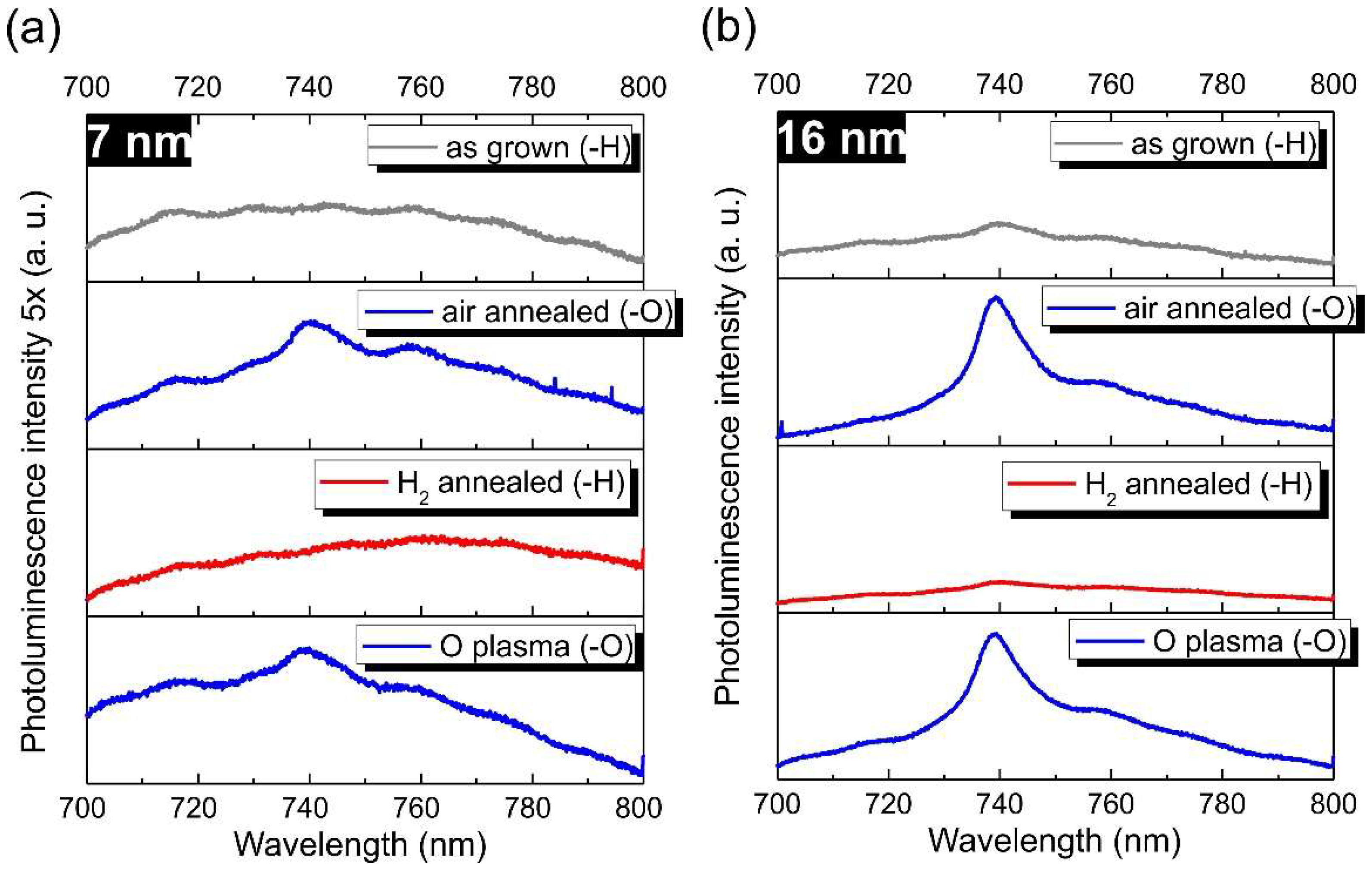
| Sample | C, at.% | O, at.% | Si, at.% |
|---|---|---|---|
| 7 nm H1-NCD2 (H-plasma; as grown) | 93.9 | 3.9 | 2.2 |
| 7 nm O2-NCD2 (air-annealed) | 88.1 | 10.1 | 1.8 |
| 7 nm H3-NCD2 (H2-annealed) | 96.1 | 1.8 | 2.1 |
| 7 nm O4-NCD2 (O-plasma) | 87.9 | 10.3 | 1.8 |
| 16 nm H1-NCD2 (H-plasma; as grown) | 96.4 | 3.4 | 0.2 |
| 16 nm O2-NCD2 (air-annealed) | 90.4 | 9.4 | 0.2 |
| 16 nm H3-NCD3 (H2-annealed) | 99.2 | 0.5 | 0.3 |
| 16 nm O4-NCD4 (O-plasma) | 91.2 | 8.5 | 0.3 |
© 2018 by the authors. Licensee MDPI, Basel, Switzerland. This article is an open access article distributed under the terms and conditions of the Creative Commons Attribution (CC BY) license (http://creativecommons.org/licenses/by/4.0/).
Share and Cite
Stehlik, S.; Ondic, L.; Varga, M.; Fait, J.; Artemenko, A.; Glatzel, T.; Kromka, A.; Rezek, B. Silicon-Vacancy Centers in Ultra-Thin Nanocrystalline Diamond Films. Micromachines 2018, 9, 281. https://doi.org/10.3390/mi9060281
Stehlik S, Ondic L, Varga M, Fait J, Artemenko A, Glatzel T, Kromka A, Rezek B. Silicon-Vacancy Centers in Ultra-Thin Nanocrystalline Diamond Films. Micromachines. 2018; 9(6):281. https://doi.org/10.3390/mi9060281
Chicago/Turabian StyleStehlik, Stepan, Lukas Ondic, Marian Varga, Jan Fait, Anna Artemenko, Thilo Glatzel, Alexander Kromka, and Bohuslav Rezek. 2018. "Silicon-Vacancy Centers in Ultra-Thin Nanocrystalline Diamond Films" Micromachines 9, no. 6: 281. https://doi.org/10.3390/mi9060281
APA StyleStehlik, S., Ondic, L., Varga, M., Fait, J., Artemenko, A., Glatzel, T., Kromka, A., & Rezek, B. (2018). Silicon-Vacancy Centers in Ultra-Thin Nanocrystalline Diamond Films. Micromachines, 9(6), 281. https://doi.org/10.3390/mi9060281







